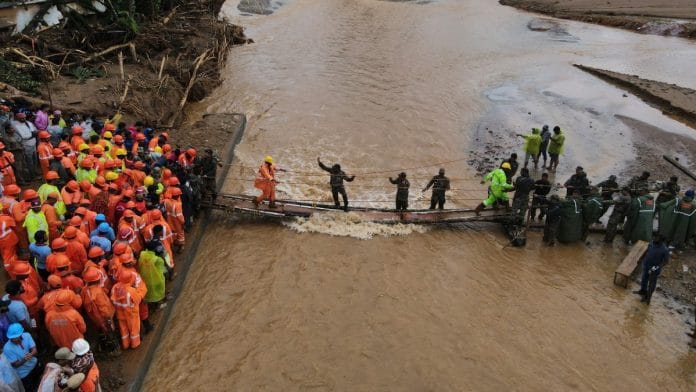Wayanad: Meppadi village in Kerala’s scenic Wayanad district is a popular tourist destination year-round, known for its picturesque tea plantations, misty mountain tops, adventure spots, and a 100-feet glass bridge at 900 Kandi. Now, the once-bustling resorts are empty, replaced by the sirens of ambulances, fire brigades, and police units marking the region’s entrance.
The landslides that struck Wayanad on Thursday, claiming over 300 lives, have buried Mundakkai, Chooralmala, and Attamala under debris. The tea plantations in Wayanad, home to many migrant workers, have been devastated. With the death toll continuing to rise and hundreds still reported missing, the Wayanad landslides are ThePrint’s Newsmaker of the Week.
In just 48 hours on 28-29 July, the rain gauge in Kalladi, nearly a kilometre from Chooralmala, received 572 mm of rainfall. Survivors report that local authorities had warned about the impending disaster and advised moving to safer locations. Those who heeded these warnings and relocated to safer rehabilitation centres are among the few who survived.
Despite previous landslides, including fatal ones in the past, the signs of danger were ignored. This disaster should be a wake-up call to address rapid tourism development, unchecked urbanisation of the hills, and illegal quarrying and mining in Kerala, where 48 per cent of the land is covered by the ecologically sensitive Western Ghats.
Also read: Explained with maps: How topography, human density led to devastation in Kerala’s Wayanad
Need for rapid response
According to the Meppadi Gram Panchayat, three wards affected by the landslide—Attamala, Mundakkai, and Chooralmala—had over 1,000 households, of which 560 houses were destroyed. Mundakkai was hit hardest, with the town nearly flattened.
This is not the first landslide to impact Meppadi. In 2019, a landslide in Puthumala, nearly 7 km from Mundakkai, claimed 17 lives. Another deadly landslide in Mundakkai in 1984 resulted in 14 deaths. A minor landslide struck the area in 2020, but did not make headlines due to the lack of fatalities.
Meppadi panchayat officials had visited the area a week before the disaster, urging residents to shift to safer places. On the night of the landslide, officials also sent out warnings via WhatsApp. While some residents heeded the advice, many remained in their homes, not anticipating the severity of the disaster.
“We can’t blame the panchayat,” 63-year-old Khadiyumma told ThePrint. Hers was one of the few families in Punchirimattam locality in Mundakkai that relocated after the warning. As she sat in the government lower primary school with other survivors, she recalled her neighbours who refused to move out of their homes. The family of three didn’t survive with one body yet to be recovered.
The disaster underscores the need for decisive action in emergencies. There should be stronger mechanisms to educate local residents about the dangers of living in disaster-prone areas and to ensure prompt response efforts to minimise risks.
Also read: Wayanad paying the price because Kerala ignored Gadgil report. Landslide is wake up call
Climate change and Kerala’s vulnerability
In 2011, the Ministry of Environment and Forests established the Western Ghats Ecology Expert Panel (WGEEP), also known as the Gadgil Commission, to assess the impacts of climate change in the western Ghats and identify ecologically sensitive areas.
The report designated 15 taluks in Kerala as Ecologically Sensitive Zone 1(ESZ1), two in ESZ2, and eight in ESZ3. Wayanad was marked as an Environmentally Sensitive Locality (ESL), with Vythiri Taluk, including Meppadi panchayat, classified as ESZ1. Most of the ESZs in Kerala are located in the northern districts of Kozhikode, Kannur, Wayanad, Malappuram, and Kasaragod.
The report recommended stringent measures for ESZs, including bans on new hill stations, strict tourism policies, and rigorous approval processes for new construction and infrastructure. However, these suggestions faced protests across the state, with concerns about their impact on local livelihoods.
In 2013, the K Kasturirangan-led working group and an expert committee also proposed including the affected region in ecologically sensitive areas. Although draft notifications were issued based on these recommendations, none have been finalised.
Now, the proposals for stricter environmental regulations occasionally make headlines, particularly when disasters like like this week’s devastating landslides in Wayanad occur.
Views are personal.
(Edited by Prashant)






